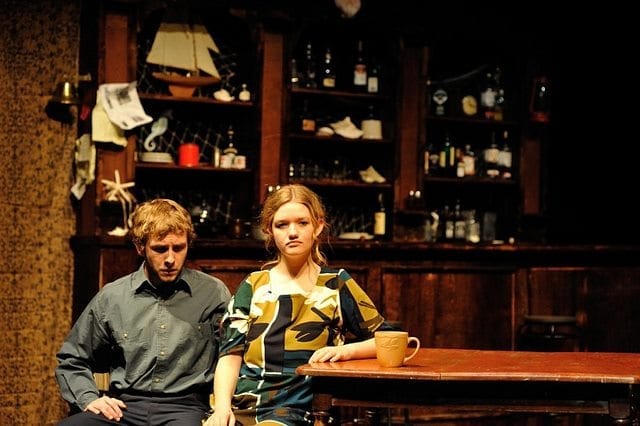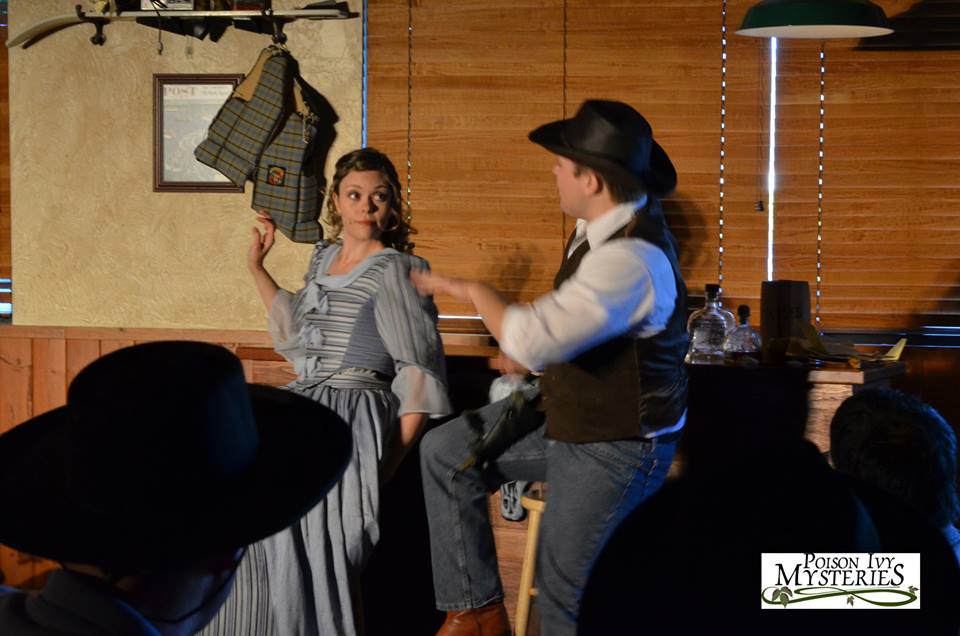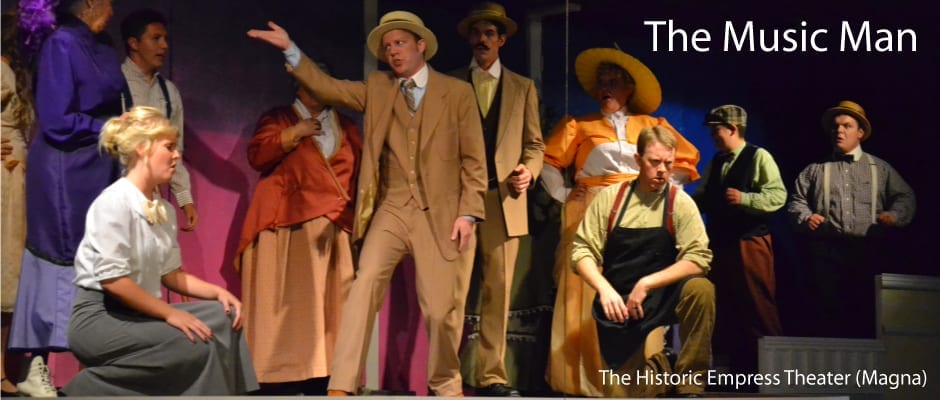SALT LAKE CITY — Academic theatre can be tough. Collegiate stages across the country struggle to find shows to please their audiences while considering their gender-imbalanced pool of actors and just the right ratio of more recent works to those from the classical canon for every season. Meanwhile, there’s a whole world of magic the public never gets to see because it occurs in the acting class where exploration and experimentation is not the exception but the norm, and where plays are performed for their content and construction, regardless of cast size and popularity. Director Michael Vought should be applauded for his effort to bridge the divide between what goes on in acting class and what the academic audience gets to see, even if The Sea Horse itself isn’t the very best vehicle for this exercise.
Vought opens the play himself explaining the experiment and its history. In one of his acting classes, a group of students staged back-to-back scenes from Edward J. Moore’s two-person play The Sea Horse utilizing different actors for each scene. The results, Vought explains, were impressive, guiding the class to realize the extent to which each of the actors could find a piece of the characters in themselves while also leading the audience to that same identification. Vought then chose to bring this exercise to Westminster’s season, utilizing five different actresses and three different actors to play the two roles. And there’s one more twist. The actors don’t know what scene they will be playing or who they will be playing with until moments before the show. Vought calls them all out in front of the audience, and they draw coins from a hat. On each coin their scene is indicated, and those up first take their places while the others sit down to watch at the front of the stage. It’s an intriguing and effective beginning to a show, one that naturally builds excitement and anticipation. In fact, the excitement of the exercise is what carries The Sea Horse. Staged traditionally, even with the excellent direction Vought provides, The Sea Horse would be only an average production.
The 1974 play takes place in a seaside tavern called The Sea Horse. It opens after hours, with Harry banging on the door, begging Gertrude to let him in. She finally does so, and they immediately begin their banter. Harry has been out for some time on a fishing vessel, and Gertrude learns quickly that he’s changed. He eventually reveals that he had a vision of his life with a little boy, and he wants Gertrude to help him make it a reality. His profession of love and his subsequent marriage proposal are met with hostility and, at times, violence. The entire play is a merry-go-round of sorts, with Harry trying to draw Gertrude into emotional and physical intimacy, and Gertrude adamantly and repeatedly rejecting his advances. Only toward the end of the drama does Gertrude finally open up, revealing a tragic past full of loss and abuse that prohibits her from accepting the possibility of a loving relationship with Harry.
 The Sea Horse is not without its merits. Moore’s language often seeps into a nice poeticism, and there is humor enough to foil the pathos. In the end, however, it is too much of the same. Harry’s repeated advances and Gertrude’s constant refusals are downright exhausting. In addition, Harry possesses a vulnerability that is endearing, but Gertrude is all injury and anger, and it is difficult for an audience to feel anything more than pity. My feminist inclinations were working overtime during this production. Even when Gertrude initiates sexual action, it seems that she does so with a misguided objectification of herself. It’s not that people like Gertrude don’t exist in the world. They do. It’s just that their stories are depressing.
The Sea Horse is not without its merits. Moore’s language often seeps into a nice poeticism, and there is humor enough to foil the pathos. In the end, however, it is too much of the same. Harry’s repeated advances and Gertrude’s constant refusals are downright exhausting. In addition, Harry possesses a vulnerability that is endearing, but Gertrude is all injury and anger, and it is difficult for an audience to feel anything more than pity. My feminist inclinations were working overtime during this production. Even when Gertrude initiates sexual action, it seems that she does so with a misguided objectification of herself. It’s not that people like Gertrude don’t exist in the world. They do. It’s just that their stories are depressing.
As a vehicle for an acting exercise, The Sea Horse at first seems as if it would be well suited to the task. There are extreme transitions for both characters from sorrow to violence and from arousal to regret. It truly is fascinating to watch the actors pick up characters mid-scene, to pass and grab the baton as Gertrude and Harry go back and forth in their struggle. That said, I was left wanting more for them to work with, and The Sea Horse just does not have it. I would love for this exercise to be repeated, but with a roller-coaster instead of a merry-go-round. In addition, it is worth noting that, practically, The Sea Horse was not the best choice due to the physical description of the character. Over and again Gertrude’s obesity is referred to in the play, but even with the spare tires and sagging breasts the actresses donned under their costumes, obese they were not, and the disparity between the text and the stage was, quite simply, distracting.
Despite flaws with the script, the production values of The Sea Horse are commendable. Vought’s direction was complemented by the simple but effective design elements. As noted, costume designer Nina Vought fitted them with body-changing pieces under their costumes that were appropriate to Gertrude’s unkempt and uncaring appearance. The Harries were also appropriately garbed for seamen with bigger plans.
The black box set was suitably designed by Emilio Casillos to represent the worn-down seaside tavern. The nautical ambiance is suggested upon entrance to the theatre with fish nets strung overhead interspersed with seashells and sailing rope, and there are nice details gracing the prominent bar at the back of the stage.
With the roles divided up among so many people who are unaware what they will be playing on any given night of the run, uneven acting could easily result, but that is not the case. In fact, with moments of few exception, the acting is excellent overall. Gertrude is given life by Kelly Finley Davis, Leslie Kobinsky, Hannah Minshew, Allison Smith, and Carlie Young. The night I saw the production, Smith appeared first with a more domineering performance followed by Minshew’s more detached interpretation of the character. Young’s Gertrude became more vulnerable in her scene, and this continued with Kobinsky’s guarded portrayal until all broke down with Davis’s Gertrude, whose psychological wounds were all gaping. Niklaas Duncan, Nikola Muckajev, and Nick Yeiter appeared as Harry and gave equally diverse performances with Muckajev tenderly hopeful in his first appearance, followed by Duncan’s alcohol-fueled disenchantment and Yeiter’s angsty incomprehension.
Vought is a seasoned director, and it is evident in this perfectly-paced production. Every chance at humor in the script was highlighted. Further, the actors were led to choices that prompted strong action and reaction, and their seamless integration into the roles was impressive enough to look effortless.
Despite my misgivings about the overall dramatic value of The Sea Horse, I have no misgivings recommending the play. This kind of experimentation is exciting and rare and is certainly worthy to see. In fact, it would be worth seeing every night to see what magic takes place.






